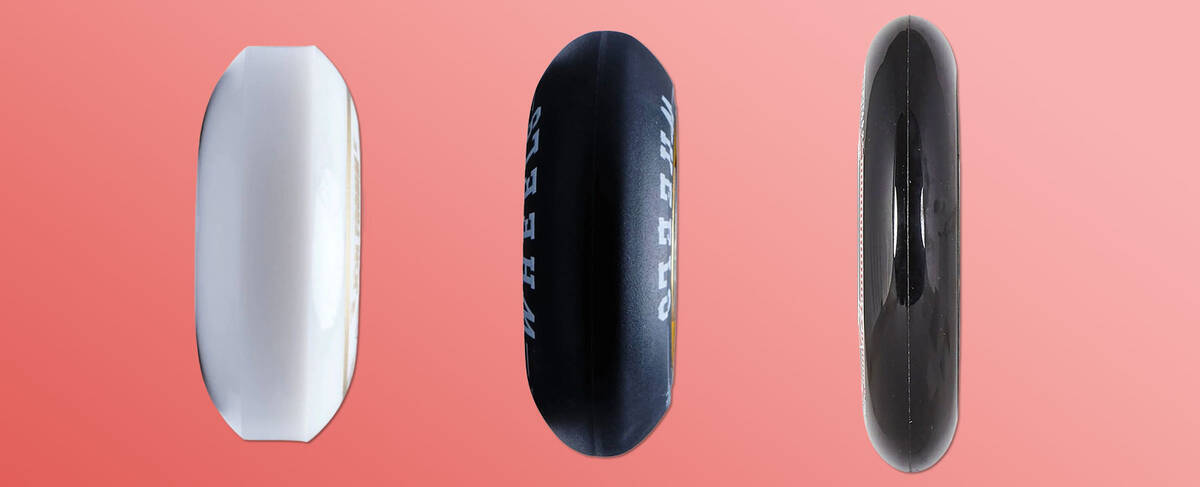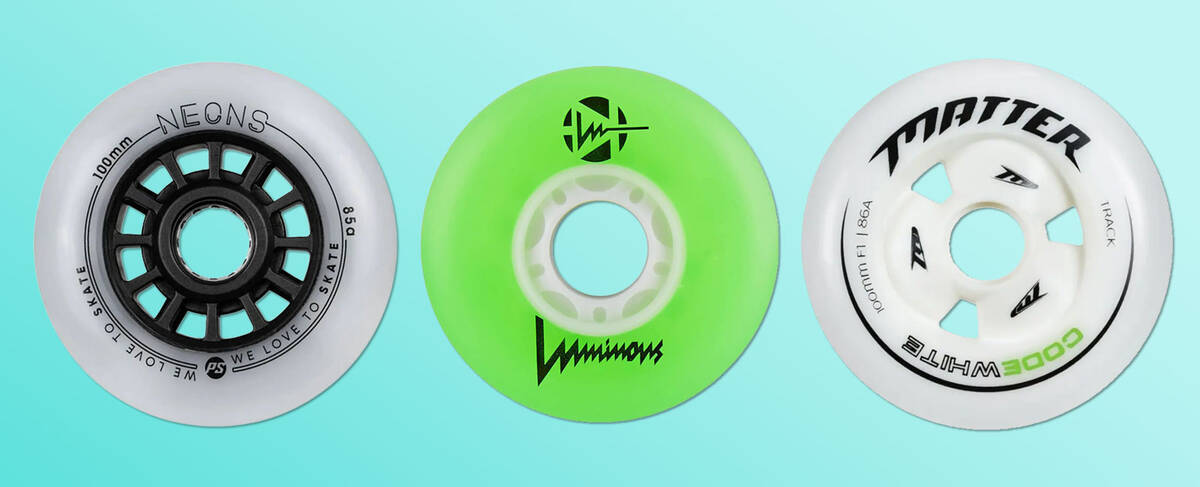Wheel terms explained

This guide contains everything you need to know about inline skate wheels. We’ll help you to make a quick decision based on your style of skating, but you’ll also get a more in-depth presentation of key terms like wheel size, durometer, rebound, grip, and wheel profile.
- Wheel size: Affects speed and maneuverability.
- Durometer: Wheel hardness – affects speed and vibration absorption.
- Rebound: How quickly the wheel snaps back to its original shape upon compression.
- Grip: Determines how well the wheel grips the surface.
- Wheel profile: Affects speed and stability.
Pregled
Pregled
What Inline Skate Wheels Should I Choose?

Choosing inline skate wheels is easier if you know what type of wheel is recommended for your style of skating.
No matter what style of inline skating you perform, you'll need to pay special attention to the size and hardness of the wheels and match these with the surfaces on which you'll be skating.
|
Inline Skating Style |
Properties |
Size Range / Hardness Range |
| Fitness Skate Wheels |
Smooth roll Power transfer
|
80-110 mm 80A-88A |
| Freeskate Wheels |
Agile and fast |
75-110 mm 84A-88A |
| Aggressive Skate Wheels |
Stable and shock-absorbing Small size Flat or round profiles |
55-80 mm 88A-95A |
| Roller Hockey Wheels |
Agile and grippy Good acceleration Some are indoors-specific |
65-84 mm 72-84A
|
| Speed Skate Wheels |
Maximum speed Indoor / rinks / outdoor / roads |
100 mm-125 mm 83A-90A |
Compatibility of Inline Skate Wheels

Inline skate wheels have a standard width of 24 mm, making it easy to find compatible wheels for your inline skates. Any wheel smaller than or equal to the maximum wheel diameter specified for your rollerblade frames can be mounted on them.
Through understanding specifics like hardness, rebound, grip, and profile you'll be able to choose wheels that not only fit but also enhance the performance of your inline skates.
Continue reading to learn more, or jump straight to our selection:
Diameter - Inline Skate Wheel Size

The diameter of an inline skate wheel is measured in millimeters (mm) and is usually printed on the side of the wheel. If you're unsure, you can measure the diameter yourself.
Wheel diameter significantly affects the behavior of inline skate wheels. Factors such as acceleration, speed, maneuverability, and directional stability are directly influenced by the size of your wheels.
Here's how wheel diameter impacts the performance of inline skates:
- Smaller diameter: Better acceleration and easier to control.
- Larger diameter: Higher top speeds and more directional stability.
The recommended wheel diameter is different for each style of skating. In the chart below, we’ve given our general recommendations for each style of inline skating:
Inline Skate Wheels Size Chart
| Inline Skating Style | Size Range |
| Aggressive Skate Wheels | 55-80 mm |
| Roller Hockey Wheels | 65-84 mm |
| Fitness Skate Wheels | 80-110 mm |
| Freeskate Wheels | 75-110 mm |
| Speed Skate Wheels | 100-125 mm |
Durometer - Inline Skate Wheel Hardness

The relative hardness of rollerblade wheels is typically measured in durometer, a standardized method for measuring the hardness of materials like rubber and plastics. The A-scale is most commonly used to classify rollerblade wheel durometer. You’ll see a number followed by an A (e.g., 82A), where a higher number indicates a harder wheel.
The A-scale helps you quickly identify the relative hardness of different wheels, and you can usually find the durometer rating printed on the side of the wheel.
The ideal wheel hardness depends on your style of skating. In the chart below, you’ll see our general guidelines for choosing the right inline skate wheel hardness for your style of inline skating:
Inline Skate Wheels Hardness Chart
| Inline Skating Style | Hardness Range |
| Aggressive Skate Wheels | 88A-95A |
| Roller Hockey Wheels | 72A-84A |
| Fitness Skate Wheels | 80A-88A |
| Freeskate Wheels | 84A-88A |
| Speed Skate Wheels | 83A-90A |
Wheel hardness determines how well the wheel will perform on different surfaces and under various conditions. Always consider the hardness of the wheels you’re about to buy, as it significantly impacts your skates' performance.
Hard vs. Soft Inline Skate Wheels
It is important to understand how hardness affects the performance of your wheels – especially if you’re choosing between two wheels where one is harder than the other.
How wheel hardness influences the performance of your rollerblades:
Pros of harder wheels
- Higher speeds
- More durable
Cons of harder wheels
- Less grip
- Less absorption of vibrations
Pros of softer wheels
- Better grip
- More shock absorption
Cons of softer wheels
- Lower speed
- Less durable
The general rule for inline skate wheels is that softer wheels provide better vibration absorption and improved grip. Conversely, harder wheels offer less vibration absorption and reduced grip.
Alternative Hardness SCALES
Some brands use the footprint scale to rate the hardness of rollerblade wheels. Here’s how the footprint scale converts to the A-scale:
- F0 - equals approx. 88A
- F1 - equals approx. 85A
- F2 - equals approx. 84A
- F3 - equals approx. 83A
Rebound of Inline Skate Wheels
The term rebound describes a wheel’s ability to quickly return to its original shape after being compressed. With each stride, you compress the wheel, and if it has a high rebound, it will snap back to its original form, aiding speed. Conversely, if the wheel has a low rebound, the energy from your strides will be absorbed and won’t transfer into speed. Therefore, the rebound of your wheels significantly impacts your speed.
High rebound is often a feature of high-quality wheels. Many manufacturers label their wheels with high rebound as SHR urethane, which stands for Super High Rebound. There’s no universal way to compare the rebound of wheels, but often, cheaper wheels have less rebound, while more expensive wheels from trusted manufacturers tend to have higher rebound.
Grip of Inline Skate Wheels
The grip of inline skate wheels is influenced by the properties of the polyurethane (PU) formula used in the wheel's rubber. Wheel hardness is a significant factor in this regard.
Wheel hardness and grip correlate like this:
- Softer wheels: More grip.
- Harder wheels: Less grip.
The surface on which you roll determines how well a given wheel grips. For very slippery surfaces, such as rinks or indoor skateparks, more grip is needed to prevent sliding. On rougher surfaces like asphalt, grip is less of a concern.
Thus, when skating rougher surfaces, you can opt for comparatively harder wheels without worrying about losing traction in unwanted situations.
Wheel Profile of Inline Skate Wheels

Inline skate wheels have different profiles ranging from flat to pointy. The profile of the wheel determines the width of the point of contact between the wheel and the surface. A flat profile has a larger contact patch, whereas a pointy wheel has a smaller contact patch.
Pointy wheels are used across various skating styles, from fitness skates to performance-oriented speed skates. Their narrow contact patch minimizes friction and rolling resistance, making them highly efficient. Pointy wheel profiles dominate the market for inline skate wheels due to their versatility and desirable speed properties.
Flat wheels are used exclusively for aggressive skating. While they may not be very fast, they offer excellent stability which is beneficial for landing tricks.
Rounded wheels are commonly used for freeskating and aggressive skating. In aggressive skating, rounded wheels are often found on flat setups, where the rounded edges reduce the risk of wheel bites. They are easier to control than pointy wheels, making them a good choice for beginners who may benefit from their more forgiving nature.
Hubs of Inline Skate Wheels

The core of the wheel is the hub. The hub is centered in the wheel and keeps the bearings positioned. The hub is typically made of hard plastic or aluminum. Usually, an aluminum core has more weight to it (depending on the design), but it is also more impact resistant and durable than a plastic core.
Hubs for inline skate wheels can be divided into these main types:
- Solid core: A solid core is very strong, but also weightier.
- Spoked core: Lighter but not as durable as solid core wheels.
- Hollow core: A golden mean between low weight and durability.
For optimal performance, inline skate wheels need to be strong and durable, yet as light as possible. Lighter wheels require less energy to lift the skates, enhancing efficiency and reducing fatigue.
Inline Skate Wheels Maintenance
We recommend doing your best to prolong the lifespan of your wheels. Since the wheels typically wear down faster than any other part of the skates, careful planning can help you save money. Developing a steady wheel-flipping schedule can extend their life and keep your skates performing at their best.
A natural wear pattern of inline skate wheels is that the centerline of the wheel shifts toward the outside of the skates, creating a flat diagonal surface on the inward side of the wheels. This isn’t beneficial for your technique, and when this occurs, it’s time to rotate the wheels.
Rotating rollerblade wheels can ensure that the wheels keep a consistent shape. We recommend our guide on wheel rotation for anyone who is in doubt about how to proceed with it:
If you’re in doubt about whether it is time to get new wheels for your inline skates, you should check out our guide on the subject:
If you need help mounting your wheels, here’s the solution:
If you need advice on general maintenance of inline skates, we have an online guide that is packed with useful advice right here:
... What About Bearings?
We have separate guides dedicated to wheel bearings. This guide contains everything you need to know about how they work:
If your roll isn't as smooth as it used to be, it might be because your bearings aren't in top shape. In that case, consider giving them a thorough cleaning and a fresh lube:


